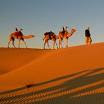 Whether you are a tourist or a resident, a visit to the Sheikh Zayed Mosque is definitely well worth the effort. And the best part - everybody is welcome!
Whether you are a tourist or a resident, a visit to the Sheikh Zayed Mosque is definitely well worth the effort. And the best part - everybody is welcome!10 years in the making, the marble-clad Sheikh Zayed Mosque is said to be the third largest mosque in the world. Decorated with thousands of rare and semi-precious stones, some encrusted in the marble, it is built on a 9.5 metre hill so it is visible from a distance. It covers an area of 22,000 sq metres and can accommodate about 40,000 worshippers. It was named after the first president of the UAE, Sheikh Zayed bin Sultan Al Nahayan who died in 2004 and was buried in the grounds of the mosque.
The main prayer hall hosts the largest dome in the world at 75 metres high with a diameter of just over 32m. The crystal chandelier, also the world's largest, was crafted in Germany, and at 10m tall and 10m wide, weighs a massive 9 tonnes. The centrepiece in the main prayer hall is a 6,000 sq m hand-made Persian carpet of intricate designs on which 9,000 Muslims pray every Friday.
All around the main prayer hall and the mosque grounds there are columns decorated in Mother of Pearl floral patterns - there are over 1,100 columns in all. The domes, many in Moroccan style are decorated with gold leaf and are inscribed with Islamic scripture. There are walls decorated with vividly coloured Turkish tiles, and Chinese and Indian green and white marble structures are dotted around the mosque grounds.
The mosque is beautiful, opulent and stunning, but at the same time there is a feeling of serenity and a calmness that is unexpected with a few hundred visitors and a few hundred more workers still working on the mosque, both inside and out. You could quite easily sit on that huge Persian carpet for hours contemplating life without anyone taking the slightest bit of notice. Of course we visited in the morning before prayer time so it was easy to take our time.
The Abu Dhabi Tourist Authority (ADTA) arranges guided tours every day except Friday and Saturday, and the guides are very informative and happy to answer all questions. Both men and women must remove their shoes before entering the prayer halls (there are lockers to store your shoes), but you can wear socks. Women must cover their hair and be modestly dressed. Abayas and sheylas are provided if you don't have any of your own. Men should wear trousers rather than shorts. Eating and drinking is not allowed in the prayer halls but you are offered cartons of water after the tour has finished. Photographs are allowed in all areas except Sheikh Zayed's tomb.
It is hoped that the mosque will be fully completed by the end of Ramadan 2009. This includes all parking areas, landscaping, an Islamic Studies Centre, a library and ADTA offices.
